October 29, 2017
Halloween Happenings at Buckhorn Inn
We love celebrating holidays at the Buckhorn Inn–and Halloween is no exception! Innkeeper Lee Mellor recently conducted a pumpkin carving workshop for our guests. They made some amazing Jack-o-lanterns!
Have you ever wondered from where the tradition of pumpkin-carving came?
A Brief History of Halloween Jack-o-lanterns
It all began with an Irish folktale. The tale revolves around Stingy Jack, who fooled the devil twice. When he eventually died, he was too dishonest to go to Heaven. But the devil had been tricked into promising not to claim his soul. The devil sent him away from the gates of Hell with a single burning coal to light his way. Ever resourceful, Jack carved out a turnip to use as a lantern. In Ireland and England, children would put burning embers in carved turnips, beets, gourds, or potatoes and used them to frighten passers-by. The glowing vegetables often were placed by the front door of homes in order to scare away the spirit of Stingy Jack. The use of vegetable lanterns became associated with Samhain, an autumnal Celtic festival that marked the end of the harvest season.
When the Irish, English, and Scots came to the United States, they brought this tradition with them. Pumpkins, native to South America but long cultivated by Native Americans, became the perfect canvas for creating Jack-0-lanterns. In the early 1800’s, the celebration of Samhain was replaced by the Halloween traditions we know today.
If you carve a pumpkin this year, roasted pumpkin seeds make a delicious seasonal snack. You can find a recipe with several variations at http://www.foodnetwork.com/recipes/food-network-kitchen/pumpkin-seeds-recipe-2105941.
Jack-0-lanterns are one of the most common Halloween decorations. In legend they keep away evil spirts or guide lost souls home. But today they serve as a flickering sign of the season.
October 23, 2017
Mount Le Conte is Buckhorn Inn’s Backyard
Rising 6,593 feet, Mount Le Conte accounts for the majestic view from the Buckhorn Inn veranda. It is the highest peak in the Great Smoky Mountains National Park that is entirely within the state of Tennessee. It is the third-highest peak in the national park, behind Clingman’s Dome and Mount Guyot.
Who is Mount Le Conte named after? There is a bit of controversy about that. Joseph Le Conte is listed by the United States Geological Survey as the famous geologist for whom the mountain was named. Others believe the mountain was in fact named for Joseph’s brother, John Le Conte, who was a physicist at South Carolina College. What we do know for sure is that Paul Adams, an enthusiastic hiker, had a major impact on this area. In 1924 he joined the Great Smoky Mountain Conservation Association, whose mission was to make the region into a national park. As part of the campaign Adams led a group of Washington DC dignitaries on a hike up the mountain so that they could appreciate first-hand its rugged beauty. The trip was successful and eventually the entire region became protected as part of the Great Smoky Mountains National Park.
There are five trails that hikers may use to reach the summit of Mount Le Conte. They are the Alum Cave, Boulevard, Bullhead, Rainbow Falls, and Trillium Gap Trails. Millions of years of erosion and weathering have given Mount Le Conte its gently sloping shape. It is composed largely of sandstone, siltstone, and shale that was formed hundreds of millions of years ago. One remnant of the Ice Age can be seen today–a dense stand of Southern Appalachian Spruce-Fir Forest blankets the upper slopes.
Lodging at the Top of Mount Le Conte
The Le Conte Lodge, established in 1925, is the inn with the highest elevation in the eastern United States. Guests may only access the lodge by hiking. Its inaccessibility means that supplies are brought to the lodge by llama train and helicopter. http://www.lecontelodge.com
During your next visit to the Buckhorn Inn we encourage you to appreciate Mount Le Conte, whether that means hiking to the summit or enjoying the view, spiced tea in hand, from one of our veranda rocking chairs.
October 16, 2017
Fall Color in the Great Smoky Mountains
Guests often ask us when is the best time to see the beautiful fall color in the Great Smoky Mountains. Our honest answer: “It depends”! Fall color timing depends on a wide variety of variables, making peak times impossible to predict.
We do know, however, that the autumnal hues light up the landscape for as long as seven weeks each year. The colors begin first in the higher elevations, then gradually move downward. Adding to this extended show is the fact that the Smokies are home to more than 100 varieties of native trees, most of them deciduous.
Most years the displays in the very highest elevations may be seen as early as mid-September, with colors visible from Clingman’s Dome Road. The colors in the middle and lower elevations can peak anywhere from mid-October through mid-November. According to http://www.gatlinburg.com/event/autumn-color-in-the-smokies, visitors can expect to enjoy beautiful colors from sugar maples, scarlet oak, sweet gum trees, red maples, and the hickories.
What Causes the Fall Color Change?
Cooler temperatures and longer nights cause the green pigment in the leaves to deteriorate. Carotenoids, the pigments that makes the leaves yellow (and carrots orange!) become more prominent. Red and purple colors come from anthocyanins. This pigments are formed when leaf sugars break down in bright sunlight.
We recommend the Roaring Forks Motor Nature Trail and the Blue Ridge Parkway as being especially scenic drives this time of year. The National Park Service http://www.nps.gov/grsm/planyourvisit/fall-suggestions recommends the following fall hikes: Appalachian Trail, Inspiration Point on Alum Cave Trail, Oconaluftee River Trail, Look Rock Tower, and Sutton Ridge Overlook.
Whether you have made your Great Smoky Mountain trip plans for this year, or are looking forward to 2018, remember that the fall color season typically lasts from mid-September through early November. This is a busy time of year, so we advise making your travel plans far in advance. Feel free to check with us at the Buckhorn Inn periodically–we sometimes have cancellations and then you can book accommodation with short lead times. Our dining room fills up quickly this time of year, so we encourage you to make your dinner reservations early. And don’t forget that Buckhorn Inn guests can pre-order hearty sack lunches to enjoy on a scenic drive or beautiful hike.
Happy fall!
October 9, 2017
Comments from our Guests
We were so happy to meet guests James and Cheryl Nipper this September. The Nippers were first-time
Buckhorn Inn visitors from Jacksonville, FL and were so warm and friendly.
He is an attorney, but we suspect also a photographer because he took some great shots of the Inn. James described the Inn as “laid-back, quaint, all-Southern”. We were so flattered when he said the Inn reminds him of what he sees in Southern Living! We actually have been in the magazine several times. Here is a “throwback” recommendation on our dining room from 2008! http://southernliving.com/travel/south-central/cozy-cabin-getaway-two
Guests Enjoy Buckhorn Grounds
The Nippers especially enjoyed the view of Mount LeConte from their room, and pointed out that it is the highest point in the Smoky Mountains that is fully situated in Tennessee. They walked the Buckhorn Inn Nature Trail and took some great photos of the pond. James says the scene reminds him of the movie “On Golden Pond”. He was kind enough to give us permission to share some of the great photos they took at the Buckhorn Inn. We are sharing them with no filters or special effects–we think they are gorgeous “as is”! We look forward to the Nippers’ next visit and in the meantime, please enjoy their photos.
Share Your Buckhorn Experience
We love seeing and sharing photos taken by our guests. Please send them by email to [email protected] along with a few descriptive comments. If you are on Instagram, please tag @innbuckhorn. Seeing the property through the eyes of our guests often gives us a brand new appreciation and perspective!
October 2, 2017
Carp-e Diem! New Denizens of Buckhorn Pond
Have you visited Buckhorn Pond? The spring-fed pond was created after Douglas Bebb built a dam there in the early 1950’s. The pond was designed with an ingenious overflow to protect the dam during heavy rains. Bass, carp and perch make their home here, as well as frogs, turtles and a few snakes. The brilliantly-colored wood duck, spotted sandpiper, heron, and other water fowl are attracted here.
We are responsible caretakers of our property, and invited a representative from the Tennessee Department of Natural Resources to review Buckhorn Pond and provide advice. He told us that our water and surrounding area is in excellent shape! His only recommendation was that a species of carp, the grass carp, could help us more easily maintain optimum levels of water plants.
Grass Carp Released in Pond
Our research revealed that the local farmers’ co-op is visited about once a month by a truck selling live fish. We went there on “fish truck day” and purchased six 12″-long triploid grass carp. The size was important as the naturalist told us if they were too small they could be eaten by the bass, and if they were done growing, they would not eat many water plants.
Innkeeper John and daughter-in-law Sharon took the large plastic bags filled with water and carp down to the pier. They “tempered” the fish by adding water from the pond to the bags until the temperatures equaled. Then they lowered the bags into the water and let the fish swim out. They report the fish looked happy in their new home!
The grass carp is a large, herbivorous, fresh-water fish. It is used as a food fish in China, but in the United States and Europe used mainly for controlling aquatic weeds. The use of these fishy friends lessens use of herbicides. The fish live up to 11 years and eat three times their weight in vegetation daily. They grow rapidly, as much as 10 inches in a summer. The average length of a fully-grown grass carp is around 30″. The grass carp are sterile and will not produce young in our pond.
For more information on stocking ponds, visit http://tn.gov/twra/article/fish-for-stocking.





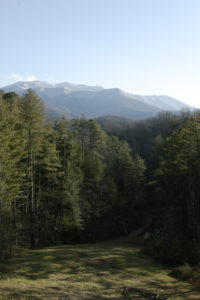
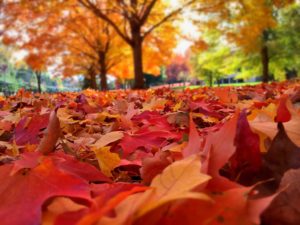

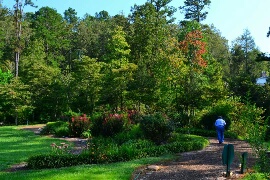
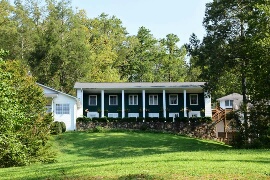


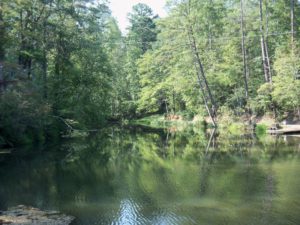
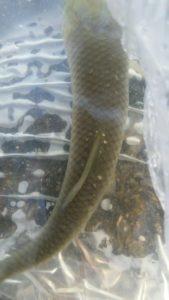

Gatlinburg Weather
Click for weather forecast